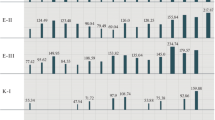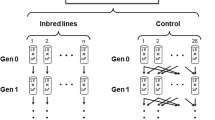Abstract
The results of three long-term breeding and genetic experiments with Drosophila melanogaster performed at different times are summarized. Selections for different fitness components led to similar results. The data on the concentration of viability mutations in the inbred strains LA, LA+, and LA− after 400 generations of selection and the strain ULA during its breeding are presented for the first time. The results of studying the genetic heterogeneity and spontaneous mutational process in Drosophila inbred strains comply with the idea of M.E. Lobashev that “a change in the direction of selection or acceleration of its rate is always accompanied by a concurrent increase in mutational variation.”
Similar content being viewed by others
References
Malogolowkin-Cohen, C., Dobzhansky, F., and Simmons, S., Inbreeding and the Mutational and Balanced Loads in Natural Populations of Drosophila willistoni, Genetics, 1964, vol. 50, pp. 1299–1330.
Wright, S., Coefficient of Inbreeding and Relationships, Am. Nat., 1922, vol. 56, pp. 330–338.
Wright, S., Systems of Mating, Genetics, 1921, vol. 6, pp. 111–178.
Kaidanov, L.Z., Mylnikov, S.V., Galkin, A.P., et al., Genetic Effects of Destabilizing Selection for Adaptive Traits of Drosophila melanogaster Strains, Russ. J. Genet., 1997, vol. 33, no. 8, pp. 935–941.
Kaidanov, L.Z., Genetic Consequences of Selection for Adaptively Important Traits (in the Experiments on Drosophila), Doctoral (Biol.) Dissertation, Leningrad, 1982.
Kaidanov, L.Z. and Subbotin, A.M., The Study of Combinative Ability of Inbred Drosophila Strains, Differing in Adaptive Value, Tsitol. Genet., 1984, vol. 18, no. 6, pp. 429–433.
Kaidanov, L.Z., The Analysis of Genetic Consequences of Selection and Inbreedings in Drosophila melanogaster, Zh. Obshch. Biol., 1979, vol. 40, pp. 834–850.
Kaidanov, L.Z., Kuksinskaya, I.S., and Meksina, N.S., A Genetic Study of the Sexual Behavior of Drosophila melanogaster: I. Breeding and Genetic Analysis of Strains, Differing in Their Sexual Activity, Genetika (Moscow), 1969, vol. 5, no. 9, pp. 116–123.
Kaidanov, L.Z. Losina, M.N., et al., A Genetic Study of the Sexual Behavior of Drosophila melanogaster: II. Restoration of High Male Sexual Activity, Genetika (Moscow), 1972, vol. 8, no. 2, pp. 84–90.
Hague, R. and Kaidanov, L.Z., Evidence for Genetic Control of Longevity in Drosophila melanogaster, Univ. J. Zool. Rajishahi Univ., 1984, vol. 24, pp. 83–84.
Amosova, I.S., Bugaeva, E.A., and Kaidanov, L.Z., Interstrain Hybridological Analysis of Thermal Resistance in Drosophila melanogaster, Genetika (Moscow), 1981, vol. 16, no. 1, pp. 109–114.
Amosova, I.S. and Kaidanov, L.Z., Thermal Resistance in Drosophila melanogaster Lines, Selected for the Differences in Adaptive Important Traits, Tsitol. Genet., 1983, vol. 17, no. 1, pp. 49–54.
Sapunov, V.B. and Kaidanov, L.Z., Interstrain Differences of Juvenile Hormone Activity in Drosophila melanogaster, Vestn. Leningr. Univ., Ser. Biol., 1979, no. 15, pp. 109–112.
Savvateeva, E.V., Labazova, I.V., Pagina, V.V., and Kaidanov, L.Z., Study of cAMP Metabolism in Drosophila melanogaster Strains Selected for the Differences in Male Sexual Activity, Dokl. Akad. Nauk SSSR, 1981, vol. 256, no. 3, pp. 715–717.
Pakhomov, A.N., Neumyvakin, L.V., Kaidanov, L.Z., and Ponomarenko, V.V., The Study of Composition of Multiple Molecular Cholinesterase Forms in Drosophila melanogaster: I. Differences between Strains, Genetika (Moscow), 1974, vol. 10, no. 10, pp. 68–72.
Tyshchenko, V.P., Osnovy fiziologii nasekomykh (Fundamentals of Insect Physiology), Leningrad: Leningr. Gos. Univ., 1977, part 2.
Kirpichnikova, E.V. and Kaidanov, L.Z., Concentration of Chromosomes with Lethal and Semilethal Mutations in Inbred Selecting Stocks LA and HA of Drosophila melanogaster, Genetika (Moscow), 1973, vol. 9, no. 4, pp. 162–165.
Pole, I.R. and Kaidanov, L.Z., Genetic Analysis of Male Sexual Activity in the HA line of Drosophila melanogaster, Genetika (Moscow), 1978, vol. 14, no. 3, pp. 470–477.
Pole, I.R. and Kaidanov, L.Z., Distribution along the Length of the X Chromosome of Mutations Controlling Low Sexual Activity of Males in the LA Drosophila melanogaster Strain, Genetika, 1978, vol. 14, no. 11, pp. 1913–1918.
Khuguto, N., Glotov, N.V., and Kaidanov, L.Z., Selection for Increased Number of Abdomen Bristles in the Inbred LA and HA Stocks of Drosophila melanogaster, Genetika (Moscow), 1980, vol. 16, no. 7, pp. 1228–1233.
Ivanyushina, V.A. and Kaidanov, L.Z., Genetic Consequences of Selection for Adaptive Traits in Inbred Drosophila melanogaster Strains, Vestn. Leningr. Univ., Ser. Biol., 1982, no. 21, pp. 76–84.
Iovleva, O.V., The Study of Genetic Heterogeniety of Highly Inbred Drosophila melanogaster Strains, Cand. Sci. (Biol.) Dissertation, St. Petersburg: S.-Petrb. Gos. Univ., 2001.
Strunnikov, V.A., Initiation of the Compensating Gene Complex is One of the Factors Causing Heterosis, Zh. Obshch. Biol., 1974, vol. 35, pp. 666–677.
Gorbunova, V.N. and Kaidanov, L.Z., High Frequency of Spontaneous Occurrence of Mutations Affecting Viability in Chromosome 2 of Drosophila melanogaster Strain HA, Genetika (Moscow), 1975, vol. 11, no. 9, pp. 71–83.
Kaidanov, L.Z. and Ryazanova, L.A., Characteristic of the Spontaneous Mutation Process in the Chromosome 2 in Highly Inbred Lines of Drosophila melanogaster, Vestn. Leningr. Univ., Ser. Biol., 1987, no. 17, pp. 84–90.
Gorbunova, V.N. and Kaidanov, L.Z., Allelism of Spontaneous Viability-Decreasing Mutations in the Second Chromosomes of LA Line of Drosophila melanogaster, Genetika (Moscow), 1976, vol. 12, no. 5, pp. 113–118.
Gvozdev, V.A., Belyaeva, E.Sp., Ilyin, Y.V., et al., Selection and Transposition of Mobile Dispersed Genes in Drosophila melanogaster, Cold Spring Harbor Symp. Quant. Biol., 1981, vol. 65, pp. 673–685.
Pasyukova, E.G., Belyaeva, E.Sp., Kogan, G.L., et al., Transpositions of Mobile Dispersed Genes Correlated with Changes in Fitness in Drosorhila melanogaster, Genetika (Moscow), 1984, vol. 20, no. 11, pp. 1772–1781.
Pasyukova, E.G., Belyaeva, E.Sp., Kogan, G.L., et al., The Study of Mobile Genetic Elements Coupled with Fitness Changes in Drosophila melanogaster, Mol. Biol. Evol., 1986, vol. 3, pp. 299–312.
Gvozdev, V.A. and Kaidanov, L.Z., Genome Variation Caused by Mobile Element Transposition and Individual Fitness in Drosophila melanogaster, Zh. Obshch. Biol., 1986, vol. 47, pp. 51–63.
Kaidanov, L.Z., Galkin, A.P., Iovleva, O.V., and Sideleva, O.G., Directed Transpositions in the Genome of the mobile hobo Element in a Long-Term Selected Strain of Drosophila melanogaster, Tsitol. Genet., 1996, vol. 30, no. 1, pp. 76–84.
Kidwell, M.G., Kidwell, J.F., and Sved, J.F., Hybrid Dysgenesis in Drosophila melanogaster: A Syndrom of Abberant Traits Including Mutations, Sterility and Male Recombination, Genetics, 1977, vol. 86, pp. 813–833.
Engels, W.R., P Element in Drosophila, in Mobile DNA, Berg, D.E. and How, M.M., Eds., Washington: American Society of Microbiology, 1989, pp. 437–484.
Louis, Ch. and Yannopoulos, G., The Genes Involved in Hybrid Dysgenesis in Drosophila melanogaster, in Oxford Surveys of Eukaryotic Genes, McLean, N., Ed., Oxford, 1989, pp. 918–927.
Blackman, R.K and Gerbart, W.M., The Transposable Element hobo of Drosophila melanogaster, in Mobile DNA, Berg, D.E., How, M.M., and Washington, D.C., Eds., Washington: American Society of Microbiology, 1989, pp. 523–529.
Pasyukova, E.G., Belyaeva, E.Sp., Il’inskaya, E.L., and Gvozdev, V.A., Transpositions of Mobile Dispersed Genes (MDG) upon the Replacement of Certain Chromosome Pairs in Drosophila melanogaster Inbred Stocks, Genetika (Moscow), 1987, vol. 23, no. 4, pp. 605–616.
Bolshakov, V.N., Galkin, A.P., Kaidanov, L.Z., et al., Closely Related Drosophila melanogaster Strains with Altered Fitness also Depict Changes in Their hobo Element Properties, Genet. Sel. Evol., 1994, vol. 26, pp. 205–216.
Kaidanov, L.Z., Bolshakov, V.N., Tzygvintzev, P.N., and Gvozdev, V.A., The Sources of Genetic Variability in Highly Inbred Long-Term Strains of Drosophila melanogaster, Genetica (The Hague), 1991, vol. 85, pp. 73–78.
Kuznetsova, O.V., Iovleva, O.V., and Kaidanov, L.Z., Spontaneous Mutation Process in HA Stocks of Drosophila melanogaster: I. Recessive Lethal Mutations in the Second Chromosome, Vestn. S.-Peterb. Gos. Univ., Ser. 3., 1996, no. 4, pp. 225–229.
Ratner, V.A. and Vasil’eva, L.A., Mobile Genetic Elements and Quantitative Traits in Drosophila: Facts and Hypotheses, Genetika (Moscow), 1992, vol. 28, no. 11, pp. 15–27.
Wilkins, A.S., Drosophila melanogaster from Oocyte to Blastoderm, in Genetic Analysis of Animal Development, New York, 1985, pp. 78–150.
Mylnikov, S.V., Dynamics of Embryonic Lethality in Inbred Drosophila Strains, Ontogenez, 1991, vol. 22, pp. 93–95.
Luchnikova, E.M., Inge-Vechtomov, S.G., Ibragimov, A.I., and Levchenko, A.B., Influence of Sterol Metabolism in Yeast Saccharomyces cerevisiae on the Metamorphosis and Reproduction of Drosophila melanogaster in the Two-Layer System: Producer-Consumer, in Issledovaniya po genetike (Research in Genetics), Leningrad: Leningr. Gos. Univ., 1981, pp. 54–65.
Bondarenko, L.V., Luchnikova, E.M., and Inge-Vechtomov, S.G., Influence of Sterol Metabolism on the Drosophila Female Fertility in Ecological Genetic System Yeasts-Drosophila, Ontogenez, 1989, vol. 20, no. 2, pp. 141–148.
Mylnikov, S.V., Formation of Adaptive Genetic System in Inbred Strain of Drosophila melanogaster Selected for a High Embryonal Mortality, Tsitol. Genet., 1991, vol. 25, no. 4, pp. 67–72.
Mazing, R.A., Analysis of Viability among Flies of Drosophila mlanogaster Heterozygous for Natural Lethals, Dokl. Akad. Nauk SSSR, 1939, vol. 25, no. 1, pp. 65–68.
Tano, S., Studies of Clustered Recessive Lethals on the Second Chromosome of Drosophila melanogaster, Jap. J. Genet., 1966, vol. 41, no. 4, pp. 299–308.
Golubovskii, M.D., Viability of Lethal Mutation Heterozygotes, Characterized by Different Concentration in Natural Drosophila Populations, Genetika (Moscow), 1969, vol. 5, no. 8, pp. 116–126.
Alexandrov, Y.N. and Golubovsky, M.D., The Multicite Mutation, Induced by Viruses and Foreign DNA Can Spread in Natural Populations of Drosophila, Dros. Inf. Serv., 1983, vol. 59, pp. 10–11.
Simmons, M.J. and Crow, J.F., Mutation Affecting Fitness in Drosophila Populations, Ann. Rav. Genet., 1977, vol. 11, p. 49.
Abrahamson, S., Wurgler, F.E., De Jong, C., and Meyer, H.U., How Many Loci on the X Chromosome of Drosophila melanogaster Can Mutate to Recessive Lethals, Env. Mutagen, 1980, vol. 2, p. 447.
Gershenzon, S.M. and Aleksandrov, Yu.N., Mutagenic Effects of Natural and Synthetic Polynucleotides and the Problem of Targeted Mutations, Zh. Obshch. Biol., 1982, vol. 43, no. 6, pp. 747–763.
Gershenzon, S.M., Aleksandrov, Yu.N., and Malyuta, S.S., Mutagennoe deistvie DNK i virusov u drozofily (Mutagenic Action of DNA and Viruses in Yeasts), Kiev: Naukova Dumka, 1975.
Aleksandrov, Yu.N. and Gershenzon, S.M., Specificity of Mutagenic Action of Synthetic Polynucleotides, Biopolim. Kletka, 1985, vol. 1, no. 1, pp. 21–25.
Ryazanova, L.A. and Myl’nikov, S.V., Characteristics of Spontaneous Mutation and Recombination Processes in Selected Inbred Strains of Drosorhila melanogaster, in V S” ezd VOGiS im. N.I. Vavilova: Tez. dokl (Abstr. V Congress of Vavilov All-Union Society of Geneticists and Breeders), Moscow, 1987, vol. 1, pp. 240–241.
Gerasimova, T.I., Hybrid Dysgenesis, Mutator Systems, and Instability Factors in Drosorhila melanogaster: Results of Genetic and Molecular Biological Studies, Genetika (Moscow), 1981, vol. 17, no. 5, pp. 773–781.
Lobashev, M.E., Physiological (Paranecrotic) Hypothesis of the Mutation Process, Vestn. Leningr. Univ., 1947, no. 8, pp. 10–29.
Author information
Authors and Affiliations
Corresponding author
Additional information
Original Russian Text © O.V. Iovleva, S.V. Mylnikov, 2007, published in Genetika, 2007, Vol. 43, No. 10, pp. 1328–1340.
Rights and permissions
About this article
Cite this article
Iovleva, O.V., Mylnikov, S.V. Consequences of selection in highly inbred Drosophila strains. Russ J Genet 43, 1108–1119 (2007). https://doi.org/10.1134/S1022795407100043
Received:
Issue Date:
DOI: https://doi.org/10.1134/S1022795407100043




